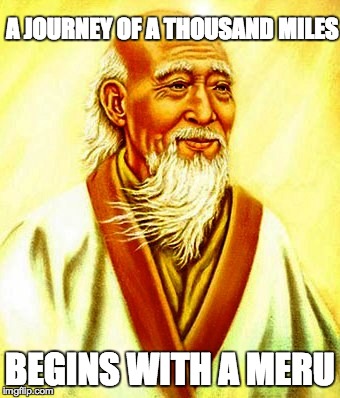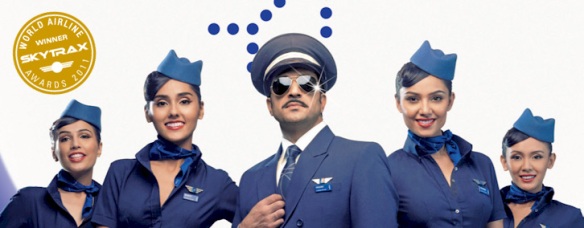Lao Tzu famously said ‘A Journey of a thousand miles, begins with a single step’. For me, it has always been a Meru. I cannot think of an occasion where I have not taken a meru to an Indian airport – irrespective of which city I have lived in. And not just to airports. Whether it is a loved one leaving home in the night or when a friend is stuck somewhere, it has always been this brand that was top of mind. I am not exactly sure how / when this kind of an extreme loyalty happened.

A few months back, we were brain storming for a campaign in our office. The question was: ‘what are the brands that you trust unconditionally’? There were many suggestions. Mine were Reynolds pens, Meru and Apple. The common thread here was the ability of these brands to deliver quality consistently, over long periods of time – to a point where you take them for granted. With Meru, quality for me was availability, punctuality and demeanor of the staff. The first two are operational, but friendliness and courtesy are softer skills. What differentiates a Meru driver for me from any other service provider is their professionalism, their customer-friendly communication skills and the evident consciousness that they are part of the service industry.
Over the years, a lot of the operational efficiency has been eroded. There have been occasions where a chauffeur has not shown up or the app has been erratic or card readers haven’t worked. There was even that one time when three cars drove up to our gate for one passenger, because of a system glitch. The fleet is ageing as well and that isn’t pretty. But the service hasn’t changed. A few weeks back, I was taking an early morning flight and took a Meru to the airport. Half way during the trip, I realized that I did not have enough cash and that the driver did not have a card reader. But thankfully there was that one road in between, where there were three ATMs. We quickly stopped at the first one, but soon I realized that the machine was out of order. Normally, I am a reasonably lucky person (I have gotten away with more shit than I should have, in life). But that morning, everything I touched was kaput. What are the odds that all three ATMs on the road would fail? Well, pretty high apparently. So I get into the car panicking, as I realized I had lost a good 15 min in all this and my last resort – the airport ATM, was at the very end of the building and will definitely jeopardize an on time check-in. I had never missed a flight in life and I was not planning on breaking that record that morning. And then the man behind the wheel said something: “Dont worry sir. You can pay me after you return to Delhi”. I clarified that I was going to be out for a week. He said he was OK. “You have my number. Call me when you return and when it is convenient for you”. I wanted to hug the man, fist bump, kiss him and buy him a beer. But then I got myself together, made a mental note to blog about him, renewed my love for Meru and dashed into the airport.

There is this other brand that I adore – Indigo airlines. Put simply, it takes a monumental vision, brilliant management and truck loads of chutzpah (Not to mention an absolutely killer Upma), to make a 600 Cr profit in a market where all of your competition is making thousands of Crores of losses. It is not just their operational efficiency that I admire, but also their entire branding. With great minds, everything can be a media property – the flight ramp, the bus, the in-flight magazine, the biscuit tin and hell, even the head rest. And when their ‘on time is a wonderful thing’ campaign broke out, I was definitely sure we had our own, homegrown Southwest. Only a better version!
But things changed a few years back. Flights were delayed, delays were rarely acknowledged, check-in experiences became disastrous, egg-shells started appearing in sandwiches, in-flight service went from non-existent to streaky to just plain absurd some times (There was this one time when I was served food 2 minutes before we commenced descent), and the staff went from being generally excitable to largely indifferent and frequently rude. I once witnessed a passenger behind me almost passing out mid-flight, but thankfully doctors were on-board that day and they recommended that the man be given some food for blood sugar. When he was revived though, he was promptly handed down a receipt and was asked to pay for the sandwich they served him – with a smile, of course.
But the tipping point for me was the 27th of September. I had another early morning flight (6:20 AM) from Mumbai to Delhi and thanks to a long check out process at the Hotel and a slightly late cab, I reached the airport about 55 minutes before take off. Too close, even for my standards. I had no check-in luggage and so immediately went to the closest counter. The lady there was servicing a customer and so I politely told her that I was taking the 6:20 Delhi (which she acknowledged) and went back to my place in the queue. Five minutes passed and then my turn came. She told me I was too late and can’t make the flight. I was a bit surprised and told her to please check again. She asked me to speak to her manager. I waited another 5 mts for her to come over and told her about my situation. She immediately declined and told me that she had ‘sent the papers to the pilot a long time back’ and I had no option but to buy a new ticket. She continued to chat with me about the ‘process’. This must have taken another 5 mts and while I was patiently listening, I was also sub-consciously analyzing my options.

Then it struck me. I looked at the watch and it was still 40 mts before take off, which meant I must have been there at least 50 mts before the flight (I was sure I had been at that counter for at least 15 mts by then, but I want to give the benefit of doubt to the airline and went with 10 mts) and so I stopped the manager and asked her to tell me what time I asked to be checked in. She asked the person at the desk, who replied “5:35 AM”. I asked how that was late (as 45 min is the legal deadline to check in and my flight was at 6:20 AM). Then she said “No sir, wait….it was actually 5:33 AM”. My tone was rapidly moving from polite to disappointed to angry, but the manager’s was consistently ‘rude’ from the beginning. Two minutes later into the discussion, I was given another time of “5:31 AM”. Now, I am not an expert on airline data systems but to put this in perspective, either this is a field that ‘is’ recorded in the system or it ‘is not’. If yes, then it is a number that doesn’t change and if not, then I am reasonably sure my watch is working. My hypothesis is that Indigo is happy to close a flight 5-10 mts before the 45 min deadline, if only a negligible number of passengers (read 0-3) are yet to check in. I am not basing this theory on one isolated incident (where all things considered, I was a borderline case), but on accounts from so many friends and colleagues. The reasons are obvious.
Two days back, my wife missed coming home for Diwali because an Indigo flight from Bhubaneswar was late by 80 mts and so she missed her connecting (Indigo) flight from Hyderabad. The treatment she was meted out by the staff at the Hyderabad airport (post mid night), when she enquired about her options was indifferent, rude and inhuman.
These incidents led me to wonder if running a tight ship meant losing the service DNA. I don’t think so. I can give you at least ten organizations who have grown in scale and trust, simultaneously – from Saravana Bhavan to Red Bus to Uber. The reason I write about these two contrasting brands together is because they make for a fascinating case study. Both are in categories where dog eats dog. Both need to analyze every measurable data point and ensure maximum efficiency to stay afloat and they do. One company seems to have its customer service DNA intact and the other seems to have lost it to some sterilization along the way. When did the ‘plastic’ nature of Indigo’s customer-facing organization set in? May be around the same time their hostesses were asked to use wigs?




